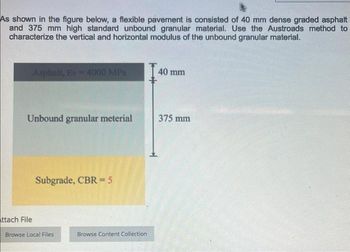
Structural Analysis
6th Edition
ISBN: 9781337630931
Author: KASSIMALI, Aslam.
Publisher: Cengage,
expand_more
expand_more
format_list_bulleted
Concept explainers
Question

Transcribed Image Text:As shown in the figure below, a flexible pavement is consisted of 40 mm dense graded asphalt
and 375 mm high standard unbound granular material. Use the Austroads method to
characterize the vertical and horizontal modulus of the unbound granular material.
Asphalt, Ev=4000 MPa
Unbound granular meterial
Subgrade, CBR = 5
ttach File
Browse Local Files
Browse Content Collection
40 mm
375 mm
Expert Solution
This question has been solved!
Explore an expertly crafted, step-by-step solution for a thorough understanding of key concepts.
Step by stepSolved in 3 steps

Knowledge Booster
Learn more about
Need a deep-dive on the concept behind this application? Look no further. Learn more about this topic, civil-engineering and related others by exploring similar questions and additional content below.Similar questions
- I need correct solutionarrow_forwardplease help with transportation problem. please make sure it is correct. Will thumbs up if correct.arrow_forwardQ1A In a Marshall test, the percentage of asphalt binder by total weight of aggregate is 5.3%. The bulk specifc gravity of aggregate (G)-2.582, the specifc gravity of asphalt binder (G)=1.000, and the density of water 3 (Yw)=1.000 g/cm. If the voids flled with asphalt (VFA) is 70.0% and the effective asphalt binder (Pbe) is 4.0% by total weight of mixture, determine the following properties: a. The absorbed asphalt binder (Pba) b. The bulk specifc gravity of the compacted mixture (Gmb) c. The voids in mineral aggregate (VMA) d. The voids in total mixture (VTM) e. The theoretical maximum specifc gravity of the loose mixture (Gmm) The effective specifc gravity of the aggregate (Gse) الarrow_forward
- A pavement consists of 5 inches of asphalt underlain by a crushed stone based course. There is no sub base. The asphalt has an elastic modulus of 350,000 psi at room temperature and the base course has a CBR of 70. Determine the thickness of the crushed stone base needed to reach an SN of 2.85. Assume the base course is saturated 5% of the time and drains within a day.arrow_forwardThe following figure shows concrete pavement with the layer thickness and elastic modulus as indicated. Assume modulus of rupture of 650 psi, load transfer coefficient of 3.2, serviceability loss from 4.5 to 2.5, and drainage coefficient of 0.9. The bedrock depth and loss of support is not considered for the subgrade. Use the design equation or monograph with 50% reliability to solve the following: 1) Determine the number of ESAL that the pavement can carry before failure. 2) If the daily traffic has 1080 single axles (20-kip), 400 single axles (24-kip), and 680 tandem axles (40-kip), and the annul traffic is the same over the design period, how many years would the concrete pavement last before failure? 8-inch Portland Cement Concrete Ec=4×106 psi 8-inch Granular Subbase Ec=30,000 psi Subgrade Mr = 5000 psiarrow_forwardProblem No: 20%) 1. In a Marshall test, the percentage of asphalt binder by total weight of aggregate is 5.3%. The bulk specific gravity of aggregate (G) -2.582, the specific gravity of asphalt binder (G)=1.000, and the density of water (7)=1.000 g/cm If the voids filled with asphalt (VFA) is 70.0% and the effective asphalt binder (P) is 4.0% by total weight of mixture, determine the following properties(10%); a. The absorbed asphalt binder (P). b. The bulk specific gravity of the compacted mixture (G) c. The voids in mineral aggregate (VMA) d. The voids in total mixture (VTM). e. The theoretical maximum specific gravity of the loose mixture (G). f. The effective specific gravity of the aggregate (G). atical specific gravity of asphalt pavement mixture necessary for Nation 91% and Marshall Densityarrow_forward
- The elastic modulus of mid-range aggregate asphalt pavement is 480 MPa while its subgrade has an elastic modulus of 55 MPa. What is the stiffness factor of the flexible pavement? 0.12 0.61 0.34 0.49arrow_forwardQ1: Find the optimum binder (asphalt) content for the results of Marshall test for base layer as bellow and check the properties of the optimum mix: %AC Density (gm/cm³) %V.T.M %V.FB Stability (N) Flow (mm) 3.0 2.200 8 60 7600 2.5 3.5 2.219 7.2 66 8500 3 4.0 2.235 4.5 72 9000 3.3 4.5 2.225 3.5 78 8800 4.2 5 2.210 2 88 8200 4.5 Specification 3-6 70-85 Min. 5000 2-4arrow_forwardProblem #1 The following figure shows the results from the dynamic modulus test for asphalt mixtures. The specimen is 4" in diameter and 6" in height. The gauge length for the axial LVDT is 4". Time lag is 0.25s. Find |E*I, and phase angle . Axial force(lbf) 65 60 40 20 0 -20 -40 -65 0 Dynamic modulus test result (gauge length = 4") 0.5 Time (second) 1 0.0010 0.0009 0.0006 0.0003 0 force (lbf) disp (in.) -0.0003 -0.0006 -0.0009 -0.0010 1.5 Axial displacement(in) 4"arrow_forward
arrow_back_ios
arrow_forward_ios
Recommended textbooks for you

 Structural Analysis (10th Edition)Civil EngineeringISBN:9780134610672Author:Russell C. HibbelerPublisher:PEARSON
Structural Analysis (10th Edition)Civil EngineeringISBN:9780134610672Author:Russell C. HibbelerPublisher:PEARSON Principles of Foundation Engineering (MindTap Cou...Civil EngineeringISBN:9781337705028Author:Braja M. Das, Nagaratnam SivakuganPublisher:Cengage Learning
Principles of Foundation Engineering (MindTap Cou...Civil EngineeringISBN:9781337705028Author:Braja M. Das, Nagaratnam SivakuganPublisher:Cengage Learning Fundamentals of Structural AnalysisCivil EngineeringISBN:9780073398006Author:Kenneth M. Leet Emeritus, Chia-Ming Uang, Joel LanningPublisher:McGraw-Hill Education
Fundamentals of Structural AnalysisCivil EngineeringISBN:9780073398006Author:Kenneth M. Leet Emeritus, Chia-Ming Uang, Joel LanningPublisher:McGraw-Hill Education
 Traffic and Highway EngineeringCivil EngineeringISBN:9781305156241Author:Garber, Nicholas J.Publisher:Cengage Learning
Traffic and Highway EngineeringCivil EngineeringISBN:9781305156241Author:Garber, Nicholas J.Publisher:Cengage Learning


Structural Analysis (10th Edition)
Civil Engineering
ISBN:9780134610672
Author:Russell C. Hibbeler
Publisher:PEARSON

Principles of Foundation Engineering (MindTap Cou...
Civil Engineering
ISBN:9781337705028
Author:Braja M. Das, Nagaratnam Sivakugan
Publisher:Cengage Learning

Fundamentals of Structural Analysis
Civil Engineering
ISBN:9780073398006
Author:Kenneth M. Leet Emeritus, Chia-Ming Uang, Joel Lanning
Publisher:McGraw-Hill Education


Traffic and Highway Engineering
Civil Engineering
ISBN:9781305156241
Author:Garber, Nicholas J.
Publisher:Cengage Learning